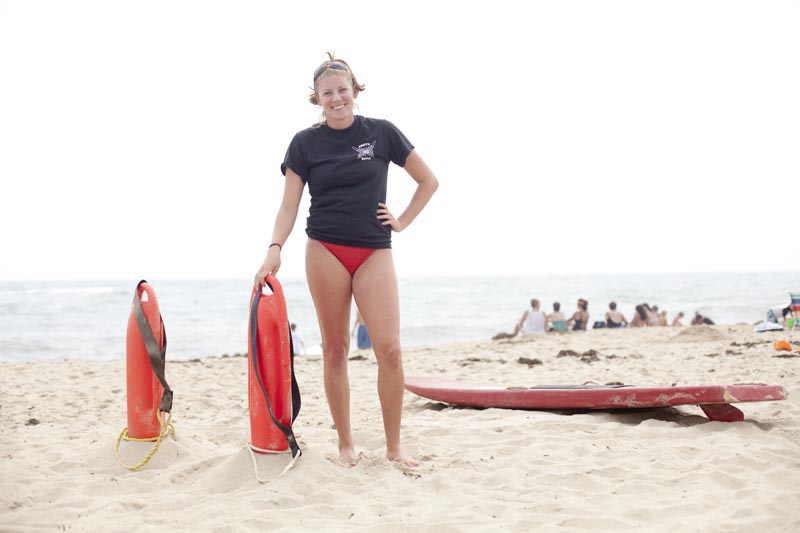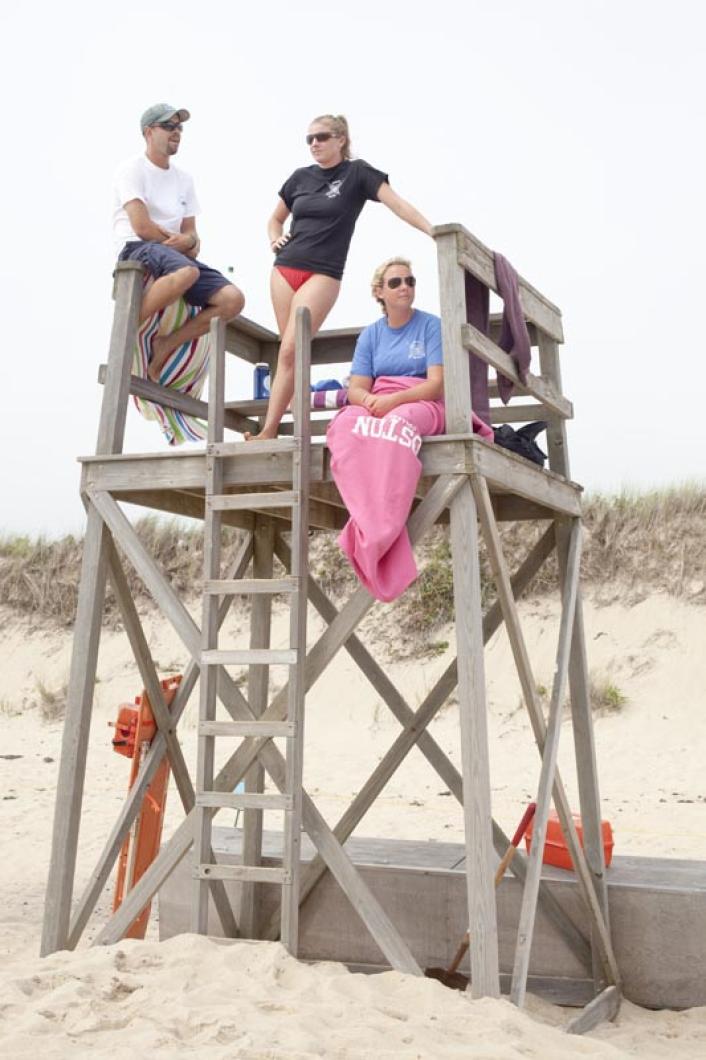Like vigilant sentinels, the young men and women who work as lifeguards of the Island are constantly scanning the horizon every day, looking for signs of danger or distress. At a moment’s notice they may be required to dive into the pounding surf to pull a swimmer to safety.
Although there are no hard numbers, they have likely saved hundreds of lives on the Vineyard over the years. And despite their bravery, many people take them for granted and sometimes treat them with disdain.
“I was up on the [lifeguard] stand the other day, and one woman walked by and said, ‘Don’t want to strain yourself up there,” said Liza Reynolds, 23, a lifeguard at South Beach in Edgartown for the past eight years. “That sort of stings a little, but I don’t take it personally . . . it’s just part of the job.”
Anyone who has worked as a lifeguard on the Vineyard knows it is anything but easy. The guards at South Beach, for example, arrive for work at 9 a.m. sharp and are quickly put through the paces by Edgartown beach director Kurstin Meehan.
Ms. Meehan, 25, who was grew up here and has worked as a lifeguard for 10 years, requires a solid hour of drills and training at the start of each day. At the beginning of the summer all guards are required to swim and run a quarter mile, and as the season progresses they are pushed to go longer distances.
By now they are each required to run a full mile and swim a full mile every day, without fail, and they will continue to run drills and perform equipment training throughout the day. “It’s a tough job. So I have to be tough,” Ms. Meehan said.

She said guards are not allowed to have cell phones on the beach, are required to wear some item of clothing denoting they are lifeguards at all times, and must keep talk over radios to a minimum. If a guard misbehaves or violates policy, they often are forced to do what are known as 50s — 50 strokes out into the water and 50 strokes back in, followed by a sprint on the beach.
“I usually make them do three of those,” Ms. Meehan said matter-of-factly. “Most of the veterans know what to do, so they don’t have to worry about doing 50s as much. But it can be a different story with the new guys; once they do 50s it usually turns them around,” she said.
The training has paid off, especially this summer, which has seen especially rough seas and high waves on most days. Veteran guards say conditions are the worst they have seen in many years.
Ms. Meehan said riptides, a strong undertow that can quickly pull a swimmer under, have been a big problem this year.
“We’re seeing big rips almost every day . . . you can just be standing there in shallow waters and suddenly you’re back on your heels and you’re getting sucked out,” she said.
The combination of rip tides and rough waters has kept lifeguards busy this summer. On Saturday alone, guards at South Beach pulled 10 swimmers in distress out of the water. “That was a tough day,” said Ms. Meehan. “But when you make 10 saves and nobody is hurt at the end of the day, then that’s a good day.”
It is less common for guards to pull someone from the water and perform CPR, but this too is an integral part of their training and has already saved at least one life this summer.
On July 18 a Braintree man was swimming in high waves at the right fork when he was knocked into the seabed, injuring his spine. He was unconscious and bleeding from the head when guards David Espindle, 20, and William Reagan, 18, reached him. “Your first thought is, this man’s dead,” Mr. Espindle told the Gazette last week. “The second thought is to do what you’re trained to do. What you practiced last week.”
Ms. Meehan soon joined the two lifeguards at the scene, and the team checked the man’s pulse and spine, strapped on a neck brace and began to administer CPR. An ambulance arrived shortly afterward and the man was transferred to a long board and driven slowly from the beach in a beach department all-terrain vehicle to a waiting ambulance.
He was then taken to Martha’s Vineyard Hospital and subsequent to Massachusetts General Hospital in Boston where he is currently undergoing rehabilitation.
There was another dramatic episode last Saturday at Quansoo Beach in Chilmark involving Ms. Reynolds, who was at Long Point Beach on her day off when she received word someone was in trouble on the other side of the man-made cut in the barrier beach that separates Tisbury Great Pond from the ocean.
She was with her family when her brother and his girlfriend went for a long walk. Ms. Reynold’s mother received a call on her cell phone and handed the phone to her. The call was from her brother, who was on the other of the cut. He told her: “Someone is in trouble. They need your help. Get here now.”
She ran down the beach, swam across the cut and continued running on the other side until she reached a crowd of people surrounding Lawrence Shedd, 49, of New Hampshire, who was unconscious and unresponsive.
She immediately took command of the situation and initiated CPR, but could not continue for long because she was out of breath after her long run and swim. So she instructed a male bystander to administer rescue breaths while she began chest compressions. “It’s exhausting work,” she said. “It’s difficult to perform on your own; the guy who wound up helping me was really good. We just switched on and off.”
Ms. Reynolds and the man continued CPR for nearly half an hour until rescuers arrived. The remote location made it difficult for police, fire and emergency medical technicians to reach the scene swiftly, so the two continued with lifesaving efforts. Mr. Shedd’s wife was there, holding husband’s hand and urging him to keep fighting.
“I kept thinking of the man rescued at South Beach a few weeks ago,” Ms. Reynolds said. “He was basically unresponsive when they found him . . . but they brought him back. So we didn’t give up.”
Mr. Shedd was later pronounced dead at Martha’s Vineyard Hospital, but Ms. Reynold’s efforts to save his life have been widely recognized and praised.
“She did everything she could,” said Marilyn Wortman, the Edgartown personnel director who also oversees the town lifeguards. “She relied on her training and worked to save him for a long time. It’s a sad ending, but she really deserved a lot of credit,” she said.
Four of the six Island towns have lifeguards: Chilmark, West Tisbury, Vineyard Haven and Edgartown.
In West Tisbury guards are posted at Lambert’s Cove Beach; in Vineyard Haven they are posted at Tashmoo Beach and Owen Park; in Edgartown they are stationed at South Beach and Bend in the Road Beach and in Chilmark they are stationed at Menemsha Beach, Squibnocket and Lucy Vincent.
The south-facing Atlantic Ocean beaches at Squibnocket and Lucy Vincent have seen the harshest surf this summer, with rip tides and large waves reported on an almost daily basis.
Martina Mastromonaco, superintendent of beaches for Chilmark, said guarding Lucy Vincent is especially challenging. The guards are not stationed on stands, and instead patrol the beach on foot. Also making things difficult is continued erosion of the beach, which has basically cut off the beach at the cliff that protrudes into the ocean.
Rough seas have not made things easier; on Monday guards at Lucy Vincent made eight rescues in a short period of time when the tide was coming in. This week all the guards were equipped with whistles to alert one another to a potential dangers; drills and training have also been stepped up during down times.
Ms. Mastromonaco said it is surprising more swimmers haven’t been injured this year considering the rough conditions, which is perhaps a credit to the dedication and diligence of lifeguards across the Island, something she agrees is often taken for granted.
“These kids take a risk too every time they go into the water to get someone. They have been trained and they know what to do, but their job is not easy, it never is . . . anyone who thinks differently should try it for a day; they’ll find out quick,” she said.






Comments (3)
Comments
Comment policy »